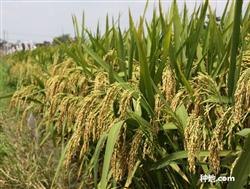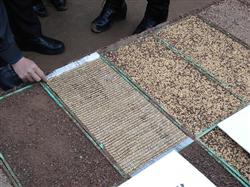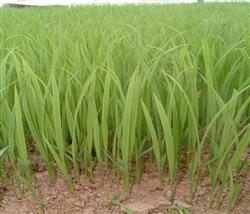How to grow more empty chaff grains in hybrid rice?

How to grow more empty chaff grains in hybrid rice? What methods can be used to control the empty seeds of hybrid rice can be controlled by the following methods: 1, according to local conditions, select good hybrid varieties with good recoverability. One is to select varieties with strong tillering ability, sufficient effective panicles, seed setting rate and high 1000-grain weight. The second is to select the varieties with moderate stem state, not too tight or loose tillers, narrow leaves, not greedy green or premature senility in the later stage. Third, the varieties with strong stress resistance and high yield can tolerate high and low temperature during flowering. 2. Broadcast early at the right time. The height of empty chaff grains in hybrid rice is closely related to the climate at heading and flowering stage, so high temperature and drought stages equal to or more than 30 ℃ should be avoided, otherwise florets abort and empty chaff grains are high. Therefore, it is necessary to determine the appropriate sowing time according to the number of days from sowing to full heading of each combination, and at the same time consider that the seedlings can live. 3. Raise seedlings with heat preservation and cultivate more tillers and strong seedlings. "the grain starts from the rice seedlings, and half of the rice seedlings are good." this shows that strong rice seedlings are the basis for high yield. Strong seedlings have a lot of dry matter, strong rooting ability and stress resistance, quick green after planting, early tillering, fast rooting, short ineffective tillering stage, sufficient nutrients, concentrated heading and flowering time, high seed setting rate and 1000-grain weight. The measures are to vigorously popularize the techniques of dry raising and throwing seedlings, to cultivate strong seedlings to increase production, to increase accumulated temperature, to accelerate growth, to shorten the growth period, to early heading and raising flowers, to avoid summer drought and to mature earlier. Strengthen the management of fertilizer and water in the seedling field, do a good job in the prevention and control of diseases and pests in the seedling field, and prevent rotten seedlings. 7-10 days before transplanting, see if the seedlings are well fertilized. 4. 2mi was managed in shallow water for 3 days after planting, and 2.5 kg urea per mu was used to promote early return to green after 7 days. Hybrid rice had fast tillering, early row closure, sturdy plants and more ineffective panicles in the later stage. The wide and narrow row cultivation of dry raising seedlings can change the population structure, not only maintain the advantages of reasonable close planting, ensure enough basic seedlings, but also maintain the advantages of wide rows, strong marginal advantage, improved ventilation and light transmission, less shade of lower leaves and high photosynthesis efficiency. it can accumulate more organic matter, reduce field humidity, inhibit the occurrence of diseases and insect pests, and increase panicle rate, seed setting rate and 1000-grain weight. 5. Balanced fertilization. Hybrid rice has large stem and leaf growth, large panicle, many grains and large fertilizer requirement, so we should adhere to the principle of "applying sufficient base fertilizer, early application of tiller fertilizer, skillful application of panicle fertilizer and appropriate application of grain fertilizer". The base fertilizer is mainly organic fertilizer, with 1500 ~ 2000 kg of mature organic fertilizer, 200 kg of plant ash, 10 kg of urea or 25 kg of ammonium bicarbonate, 25 ~ 30 kg of calcium superphosphate and 1.5 kg of zinc sulfate per mu. Hybrid rice depends on tillers to form panicles, and topdressing should be early. 10 days after planting, 5-6 kg of urea is applied to promote tillering. For the fields with insufficient growth in the early stage, the fertilizer for promoting flowers was increased at the early jointing stage, and urea was applied 4-5 kg per mu to strive for large panicle size and partial shaking tiller into panicle. After heading, 0.4% potassium dihydrogen phosphate solution 50: 60 kg was sprayed 2 times 3 times, once every 7-10 days. 1% urea solution and potassium dihydrogen phosphate could be mixed with 1% urea solution for fields with weak fertility, insufficient seedlings and fading in the middle stage. 6. Scientific management of water. Turn green in deep water, take the auricle that is not flooded at the top of the whole leaf as the degree, keep it about 5 centimeters, and create a condition of heat preservation and temperature stability. Shallow water tillering, with a degree of 1.5 cm, makes the base and soil fully exposed to light, reduces the tiller node position, shortens the tillering time, and strengthens the stem tissue. Enough seedling field guaranteed by water source, drying the field at the end of tillering, inhibiting the occurrence of ineffective tiller and enhancing plant growth potential. Hybrid rice grows vigorously at booting stage, with large leaf area and high temperature, which is the period when the physiological water demand is the most and the most sensitive to water. It should be irrigated frequently in shallow water, limited to 3-4 cm deep, to meet the water demand for young panicle development, to increase the solubility of nutrients, to ensure that matter leads to the panicle, and to adjust mud temperature and microclimate to reduce spikelet abortion and sterility. Promote heading quickly and neatly. After heading, close the 3-4 cm shallow water layer to facilitate flowering and pollination, make full use of Rain Water irrigation, protect the growth function of the old root, prolong the leaf function, facilitate grain filling to compete for grain weight, and ensure that the stem green seeds are yellow during harvest, and the big grains of the ear are full. 7. comprehensive prevention and control of diseases and insect pests. In accordance with the principle of "prevention first, comprehensive prevention and control" and on the basis of agricultural prevention and control, we should do a good job in the prediction and forecast of diseases and insect pests, strengthen chemical protection, and carry out unified prevention and control. In recent years, rice borers, rice planthoppers, rice bracts, rice leaf rollers, sheath blight and rice blast and other diseases and insect pests often occur, so we should lose no time in prevention and control to reduce the production of empty chaff grains. Click to get massive rice planting technology click to get massive grain planting technology
- Prev

How to fertilize hybrid rice?
How to sprout hybrid rice? Is there any method with good effect? in recent years, the main experiments and popularizing the new safe and rapid budding method of "seed soaking in warm water and electric blanket" have better solved the problem of seed soaking and budding of high quality rice and early hybrid rice, and have been welcomed by the majority of farmers. The main advantages of this method are as follows: first.
- Next

What are the main diseases and insect pests of rice?
How to raise rice seedlings? Methods Rice seedling raising techniques: 1: how to determine the seedling raising period? Rice seedlings were raised in heat preservation and drought, and the seedlings began to sow after the air temperature passed steadily through 5 ℃-6 ℃ (the temperature increased to more than 12 ℃ after plastic film mulching and plastic film mulching). In Heilongjiang Province, the seeds were not sown in May, and the best sowing time was April.
Related
- The first cup of black tea in spring, the flavor and history of tea gardens in Kenya, Africa
- The computer can not only choose potatoes, but also grow tea rice. AI will grow winter oolong tea champion.
- It is not only the inflated tea bitten by insects, but also engraved with the four seasons tea in Beipu.
- The Oriental Beauty Tea Festival in Zhuxian County takes the stage at the weekend to experience the plus-size feast of oil tea.
- & quot; Oriental Beauty Tea & Exploration of Emei in Hsinchu, the hometown of quot;
- The new variety of strawberry "Tainong 1" dessert is the first choice with mellow aroma. Crimson gorgeous
- History of Tea in Taiwan: from Wild Inner Mountain to Export Tea Garden
- Two types of Taiwan Oriental Beauty Black Tea won the British three-Star Award for Childhood Tea Xiang Zhang Jiaqi changed from pilot to champion tea maker.
- Banana species and varieties: the planting history of Taiwan Xianren banana and dwarf banana is long, is banana disease resistant?
- Coffee planting Technology: Qianjie Coffee from Seedling to harvesting

